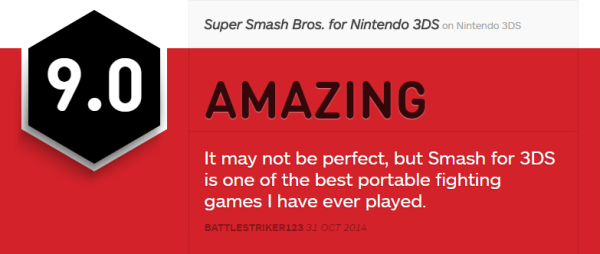A smashing good time.
At which point am I, as a reviewer, allowed to write a review for a Super Smash Bros. game? As of writing, I have put over thirty hours into Super Smash Bros. for Nintendo 3DS, collected a majority of the game’s over 600 trophies, and have unlocked about three-fourths of all the in-game achievements. Yet, I feel like I have yet to see even most of what this game has to offer; the amount of depth and nuance in the game’s deceptively simple mechanics and features lends itself to almost limitless possibilities in terms of gameplay. Every single character has his or her own unique strengths and weaknesses, every stage its own set of secrets, every mode its own distinctive traits and strategies. Very rarely does such a simple game hide such complexity, but Smash is exactly that kind of experience.
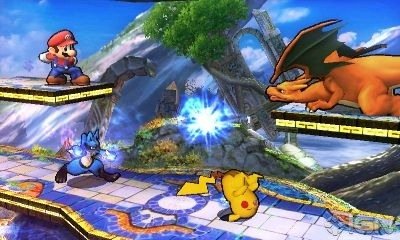
Super Smash Bros. is not your typical fighting game. Instead of having a health gauge, which goes down until the player hits zero and loses, Smash Bros. utilizes a damage gauge, which increases based on how much damage you have received, either by your opponents, by stage hazards, or the various in-game items. The more hits you take, the easier it is to get launched by enemy attacks. If you fall too far from the stage, you lose a life, and your damage gauge resets. This unique mechanic has allowed Smash Bros. to evolve much differently from many of its fighting game brethren; while those games focus much on stringing and executing combos, Smash Bros. is as much about the combat as it is about maneuvering in physical space. This makes Smash feel more like an action game than a traditional fighting game, an aspect that has sparked much debate in the professional fighting game arena.
How players execute attacks in Super Smash Bros. is also very different from other fighting games. Smash has been described as a “one-button fighter;” rather than executing moves through a string of different button presses, the basic actions in Smash are accomplished by pressing a single button (either A for a standard attack or B for a Special Attack) and tapping a direction on the circle pad simultaneously. It is easy to see then that each character has the same number of basic moves, though each have their own small nuances that gives Smash its complexity; holding B while using Link, for example, will charge up his bow and arrow to deal greater damage. While each character is unique, most of their moves follow a general pattern; for instance, tapping B while pushing the circle pad upwards will usually result in a upwards special attack, which can be used as a “recovery” move when the player fall off a ledge.
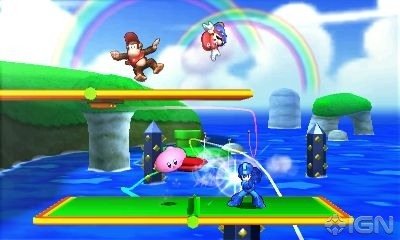
Speaking of characters, the stars of Super Smash Bros. are of course its cast of playable fighters, casted from various Nintendo franchises throughout the company’s robust history, from classic characters like Mario and Link to newer additions like the Wii Fit Trainer and Shulk from Xenoblade Chronicles. As previously mentioned, each character has their own unique moves, and they all cleverly reference their source material. Olimar, for example, attacks his opponents by throwing Pikmin at him, a mechanic that is prevalent across the Pikmin games. These characters are what make each Smash game its own, and the 3DS game does a great job balancing each character’s various strengths and weakness so that, despite its broad range of difference choices, anyone can pick up and play any character relatively quickly. Veteran players will know that it takes a while to find a character that fits perfectly to your play style, but most people eventually settle with one or two characters they like the most. It is up to you to decide what aspects of which characters you like the most; do you like fighters who move quickly, or those that deal more damage?
Even if you do not end up finding a character that suits you, Super Smash Bros. for Nintendo 3DS introduces a new feature called custom move sets. Each character has four special moves, each of which can be changed to one of three different options. These custom moves can be unlocked by playing through the game’s various modes, and it is a lot of fun experimenting with each combination to see which suits you the best. Players can also give their custom characters special equipment that give them stat boosts and buffs. Unfortunately, custom characters cannot be used online unless you are playing with friends, but they are compatible with most of the game’s many game modes, so it is certainly worth looking into them and checking them out.
The stages in Smash are almost as important as the characters. Each level is based off of a particular Nintendo franchise, and so just like the characters, they each posses unique traits as well. One of my favorites is a stage based off of The Legend of Zelda: Spirit Tracks, where you fight on top of a train as it travels through Hyrule. There does not seem to be as many stages in this game as in Brawl, but each one can be transformed into “omega” form, which resembles Final Destination (completely flat, no stage hazards, no items). Unfortuantely, there is no way to play omega stages with items on, which is a bummer.
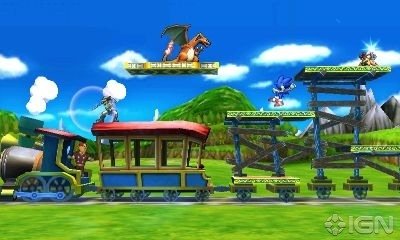
Smash for 3DS has a plethora of different modes to play around in. There is, of course, the usual “Smash” mode, where you and others can battle against each other using rules that fit your tastes. There are more traditional single-player modes to choose from as well: Classic, which pits you against a series of different fighters in different scenarios, and All-Star (new to the series), which throws you into a battle with multiple opponents chronologically relative to their debut date. There are also a number of different mini-games to choose from. Home-Run Contest makes a return and has players attack a Sandbag and see how far they can launch it from the starting position. A new mini-game called Target Blast features a unique twist on Angry Birds; players launch a bomb into a structure and try to destroy as much of it as possible. One last interesting new mode in the 3DS game is Multi-Man Smash, which lets player choose from a menu of challenges that includes 10-Man Smash, 100-Man Smash, 3-Minute Smash, Rival Smash, Endless Smash, and Cruel Smash. Each of these Multi-Man Smash challenges have their own unique set of rules, though I found myself playing some of these more than others (Cruel Smash is ridiculous and not very fun).
The biggest new mode in the 3DS version of Super Smash Bros. is Smash Run. In this mode, reminiscent of Kirby Air Ride’s City Trial, players spend five minutes running around a rather large map defeating common enemies and collecting stat boosts along the way. These boosts are strewn across the map’s various environments, as well as from defeated enemies. Once in a while, a random event will occur, one that usually results in more rewards (though a few of them may end up screwing the player rather than helping them). There are also bonus rooms that require players to complete a certain challenge within a time limit, and reward them greatly for doing so. Besides stat boosts, players can also find powers (which can be equipped on the Smash Run menu), custom move sets, Mii hats, trophies, and many other small goodies. At the end of the five minutes, all four players are transported into a final contest, which can be a race, a traditional Smash battle, or some other challenge. I find that five minutes is the perfect length for something like this, and while the final contest may not always feel fair, it is still very fun. The only problem with Smash Run is its lack of customizable options (you cannot, for example, set the time limit to less than five minutes), which is a bit odd.
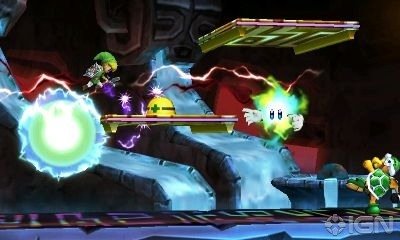
The features do not stop there. Ever since Melee, Super Smash Bros. has been all about collecting stuff. In-game challenges require players to accomplish a certain set of goals in order to win a prize, ranging from very simple (create a custom Mii fighter) to frustratingly difficult (beat Classic Mode on level 9.0). Speaking of Miis, customizing your Mii character is surprisingly fun, though I do wish there were more outfits I could unlock. The game also has over 600 virtual trophies to collect, each of which has their own witty description. Sound Test returns this time around as well, with the added functionality of playing songs while the 3DS is in sleep mode. Additionally, the game features a photo album, a replay mode, tips, fighter records, a training mode, and lots more. Needless to say, this game is packed with features, but that is not to say that nothing has been cut from the previous games. For example, item frequency cannot be set, aside from either “on” or “off,” and Coin Battle, Stamina Mode, and Special Brawl have all been removed.
There is also the issue of online play, which does not seem to have improved by much since Brawl. With friends, it plays fine most of the time, but it is nearly unplayable with strangers. The game is dependent on a strong internet connection on both ends, and unfortunately that does not often happen. Whether this is a hardware-related limitation or just a temporary server issue remains to be seen.
All things considered, Super Smash Bros. for Nintendo 3DS is a must-have for any 3DS owner. Everything you love about Smash is here: its great cast of characters, its creative new stages, it variety of different modes, and much more. Even with some of its content cut, this game is still well worth your time and money. Super Smash Bros. for Nintendo 3DS successfully brings Nintendo’s 4-player brawler onto a portable handheld, and even with the impending release of Super Smash Bros. for Wii U, the mere idea of a portable Smash game is enticing enough for a gamer like me to double dip.
